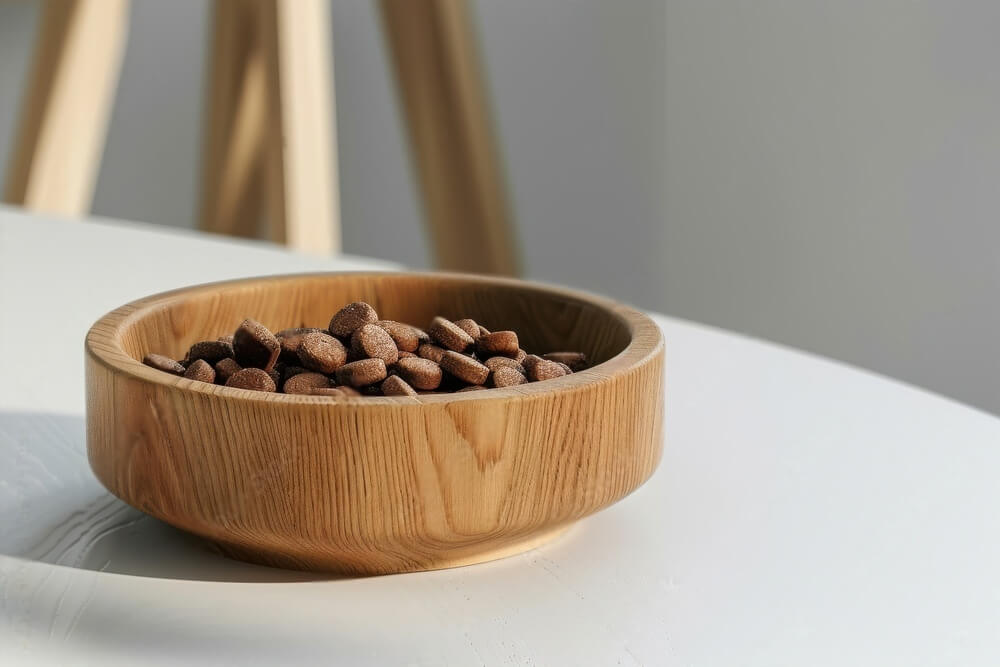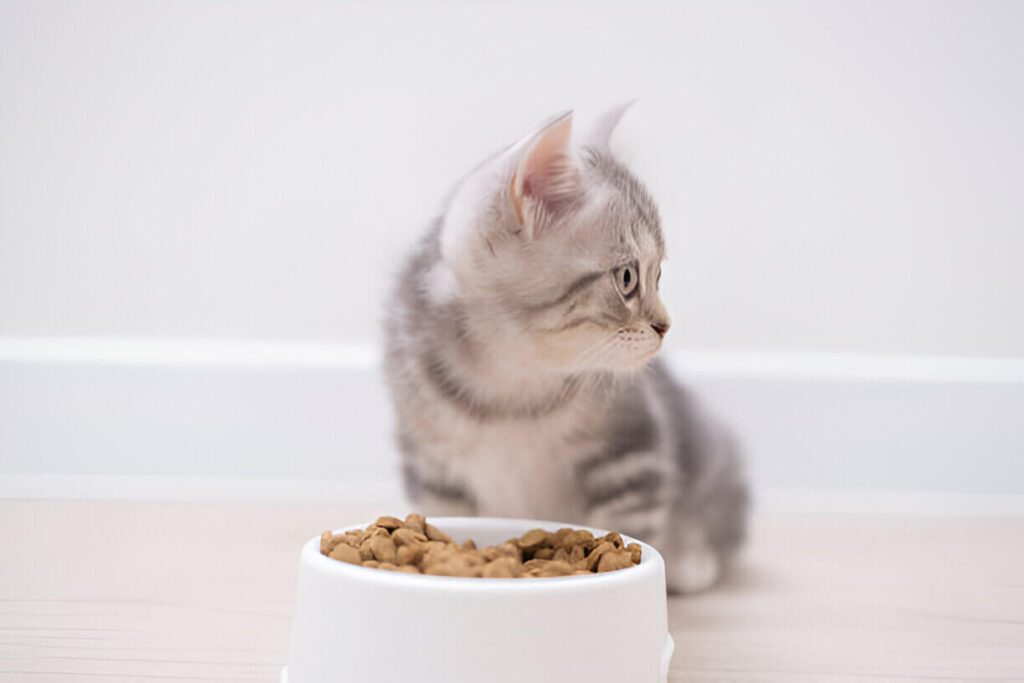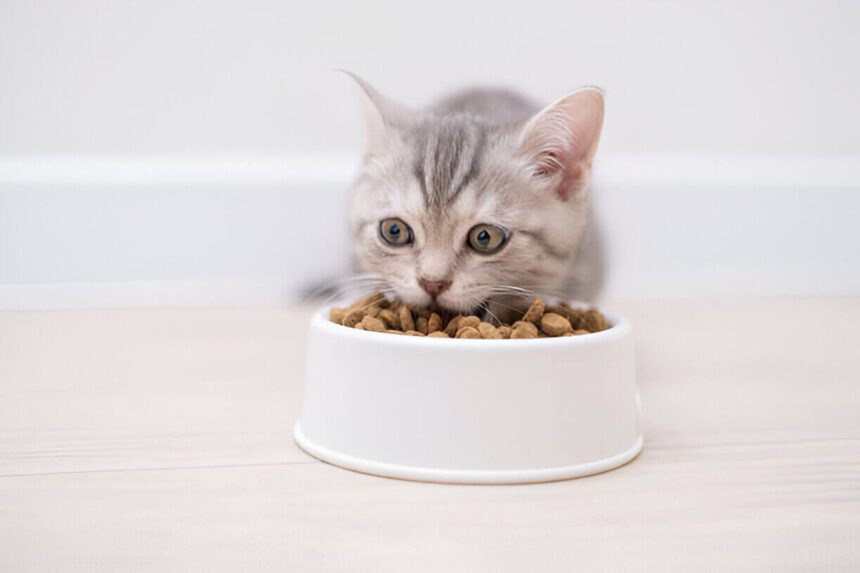When can cats eat solid food? The answer to this question depends on various factors, such as your cat’s age, stomach, and digestive system condition, and other cats in your home. Consult with your veterinarian if you are unsure how long to wait before introducing solid food.
Typically kittens under 5 weeks old should not eat solid food because they do not need it yet. They get all their nutrition from the mother’s milk until they are weaned off at 6 months old. It would be best if you did not force kittens to eat solid food too soon, or you may upset their digestive system.
Your kitten can be fed with mother’s milk only for the first ten days at six weeks old. Then gradually add a small amount of prepared chicken, turkey, and lamb baby formula mixed with water. After the first three days of solid food, mix it with the mother’s milk to avoid bacterial contamination.
Why Timing Matters
First things first, timing is everything when it comes to introducing solid food to kittens. Just like human babies, kittens have a delicate digestive system that needs to develop before they can handle more complex foods. Rushing this process can lead to tummy troubles and other health issues, so it’s crucial to get it right.
Understanding Kitten Development
Kittens grow fast, and their nutritional needs change rapidly. During the first few weeks of life, they rely solely on their mother’s milk. This milk provides all the essential nutrients they need to grow strong and healthy. But as they get older, they’ll start showing interest in solid food.
Signs Your Kitten Is Ready
You’ll notice a few telltale signs that your kitten is ready to start exploring solid food. These include:
- Increased curiosity: Kittens will start sniffing around their mother’s food bowl and may even try to nibble on solid food.
- Teething: As their baby teeth come in, kittens will want to chew on things, including solid food.
- Weaning process: Around four to six weeks, mother cats will begin the weaning process, gradually reducing the amount of milk they provide.
When Can Cats Eat Solid Food?

Alright, let’s get to the heart of the matter: When Can Cats Eat Solid Food? Generally, kittens are ready to start eating solid food between four to six weeks of age. However, it’s not a one-size-fits-all answer. Every kitten is unique, and some may take a little longer to show interest in solid food.
The Weaning Process
Weaning is a critical phase in a kitten’s development. It typically starts around four weeks of age and can continue until they are eight to ten weeks old. During this time, kittens gradually transition from mother’s milk to solid food. Here’s a simple breakdown of the process:
- Weeks 4-5: Introduce a gruel made of kitten formula mixed with wet kitten food. This should be a smooth, mushy consistency.
- Weeks 5-6: Gradually thicken the gruel by reducing the amount of formula and increasing the wet food.
- Weeks 6-8: Begin offering small amounts of dry kitten food alongside the wet food. Ensure it’s moistened to make it easier for the kittens to chew.
What to Feed
When introducing solid food, it’s essential to choose high-quality kitten food. Look for food specifically formulated for kittens, as it will contain the right balance of nutrients they need. Here are some options:
- Wet kitten food: Soft and easy to eat, wet food is a great starting point for kittens. It also helps keep them hydrated.
- Dry kitten food: As your kittens get used to solid food, you can introduce dry kibble. Make sure it’s designed for kittens and is small enough for their tiny mouths.
- Homemade options: If you prefer homemade food, ensure it’s nutritionally balanced. Consult your vet for recipes that include essential vitamins and minerals.
Is it ok for kittens to eat dry food only?
According to the veterinarian, it is best to feed your kitten with kibble and raw meat. Dry food ensures that cats get all the necessary nutrients they need, while raw meat increases the vitamins and other nutrients it can get from its natural diet.
Commercial kitten foods contain many unnecessary ingredients and preservatives that could harm your kitten’s health.
This should be avoided for good. Your cat needs all the nutrients it can get from its natural diet to grow up healthy.
How to Introduce Solid Food to Kittens?

Introducing solid food can be a bit messy, but it’s also a lot of fun! Here’s a step-by-step guide to help you through the process:
Setting Up
Find a quiet, comfortable space for feeding. Use shallow dishes that are easy for kittens to access. Keep the area clean to prevent any contamination.
Mixing the Gruel
Start by mixing a small amount of wet kitten food with kitten formula. Aim for a smooth, soupy consistency. You can use a blender to get the right texture.
Encouraging Your Kitten
Place a small amount of the gruel on your finger and let your kitten sniff and lick it. This helps them get used to the taste and texture. Gradually introduce the gruel in a shallow dish, encouraging the kittens to lap it up.
Patience is Key
Some kittens might take to solid food right away, while others may need a bit more time. Be patient and persistent. Keep offering the food several times a day and gradually reduce the amount of formula in the mix.
When do kittens stop drinking milk from their mother?
Some kittens may still drink milk from their mothers for a few weeks or even months. If you are planning to separate your kitten from its mother or if you have other cats in your home, it is best to wait until it is about five weeks old before doing so.
Please do not force your kitten to stop drinking milk from its mother because it will associate her with discomfort. You can try to offer him solid food after he has been weaned off milk, but this takes time and the use of the mother cat’s milk.
Some kittens will stop drinking milk from their mother around 5 weeks or 6 weeks of age and may take a couple of days to get used to solid foods.
The age at which a kitten stops drinking its mother’s milk varies with each individual and can take five days.
If you notice that your kitten is not drinking its mother’s milk, this could signal that he is full-grown, and it is time to introduce him to solid food.
Common Challenges and Solutions
Introducing solid food can come with its own set of challenges. Here are some common issues and how to tackle them:
Kitten Not Interested
If your kitten shows no interest in solid food, try different textures and flavors. Some kittens might prefer a smoother consistency, while others might like it chunkier. Experiment with different types of wet food and see what they prefer.
Upset Stomach
It’s not uncommon for kittens to experience a bit of digestive upset when transitioning to solid food. To minimize this, make the change gradually. Mix a small amount of new food with the old and slowly increase the proportion of solid food.
Overeating
Kittens can be enthusiastic eaters, but overeating can lead to digestive issues. Offer small, frequent meals throughout the day instead of one large meal. This helps prevent overeating and keeps their energy levels stable.
Transitioning to a Balanced Diet
As your kittens grow, their dietary needs will continue to evolve. By around eight to ten weeks, they should be eating solid food exclusively. At this stage, ensure their diet is balanced and provides all the necessary nutrients for healthy growth.
Nutritional Needs
Kittens need a diet rich in protein, fats, and essential vitamins and minerals. Look for high-quality kitten food that lists meat as the first ingredient. Avoid foods with fillers like corn and soy.
Portion Control
Follow the feeding guidelines on the kitten food packaging, but adjust based on your kitten’s growth and activity level. Kittens have high energy needs, so make sure they’re getting enough food to support their development.
Regular Vet Check-Ups
Regular veterinary check-ups are crucial during your kitten’s first year. Your vet can provide guidance on diet, monitor their growth, and address any health concerns. They can also recommend the best time to switch to adult cat food, usually around one year of age.
FAQs
At what age can cats eat solid food?
Kittens are usually weaned off milk by the time they are 6 weeks old. They should not eat solid food before this because their digestive system might not be ready.
When do cats get rid of their milk teeth?
Cats get rid of their milk teeth by 8 weeks of age but may still have them until 9 months old. If a kitten has these teeth, she should be eating solid food at 5 weeks old.
Can a 3 month old cat eat dry food?
No, solid food should be introduced to your kitten when they are 6 weeks old. You can also introduce them to canned cat food, canned pate, or kitten foods at 6 months of age.
When do cats usually start eating solid food?
Cats usually start eating solid food around 4-5 months, but some may take longer. If your kitten is over six months old, you shouldn’t force him to eat anything else but make sure his diet is well balanced.
How old do kittens have to be to eat wet food?
When kittens are about 4-6 months old, they can eat some wet food, but you should avoid giving them canned cat food until they are 8-9 months old.
Should my kitten be eating canned cat food before her teeth come in?
Cat’s teeth continue to grow after weaning, so the best time to start feeding them solid food is when they are 6 weeks old.
What do you feed a 4 week old kitten?
You should feed your kitten mashed food that is made specially for kittens. You can add some meat to this if you want.
Can a 6 week old kitten eat dog food?
No, dog food is much higher in protein than cat food, and the protein content in kittens’ food should be limited.
Conclusion
In conclusion, understanding When Can Cats Eat Solid Food is essential for the healthy growth of your kittens. By introducing solid food at the right time and in the right way, you’ll set your kitten up for a lifetime of good health and happiness. Happy feeding, and enjoy every moment with your adorable new family member!



